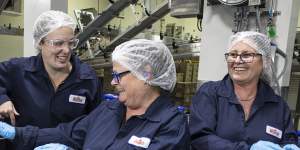Norco chief executive Michael Hampson said the farmers’ co-operative could not have rebuilt the factory without government assistance after the 14.4-metre flood on February 28 inundated the premises and destroyed valuable equipment.

Jessica Anderson,Julie Higgins and Karen Revell churn out ice-cream at Norco’s rebuilt factory in Lismore on Thursday.Natalie Grono
“I thought,‘This is going to be one hell of a clean-up’,” Hampson recalled of his first visit to the factory after the flood,when he saw giant silos ripped from their pipes and discarded on the ground.
“The financial cost was likely going to be too much for us to bear without any government assistance.”
Norco has been making ice-cream in Lismore since the 1950s,and Hampson said he wanted to reopen from day one. However,for months after the flood,as he and his team ran the numbers,no one in Lismore knew if the factory would run again.
The state and federal governments offered to put $34.7 million towards the rebuild,under a grant scheme aimed at keeping the region’s largest employers afloat after the disaster. Norco only committed to the project in October last year,after the government confirmed it could also use a previously awarded $11 million grant to fund the work.

By then it had stood down 170 of its workers,after $8 million of post-flood government wage subsidies ran out.
The final repair bill for the factory,including Norco’s contribution,came to about $104 million.
Hampson said it was money well spent – the factory had been rebuilt to endure future floods and fire,and Norco would be able to keep contributing to the local and national economies.
“The economic activity of making 45 million litres of ice-cream in Lismore a year will generate tens of millions of dollars in economic activity for that town – the milk we use from our farmers,the money we pay in wages,” he said. “The local community benefits significantly from that investment by the government.”
Footage from workers and surveillance cameras captured floodwaters as they entered the premises in South Lismore on February 28 last year. SOURCE:Norco
The factory has 130 workers back on its books,95 of them returning employees.
To protect its assets from further floods it has built two large “submarine rooms”,with heavy steel doors to hold back water. It has also installed its most valuable machinery above the 15-metre flood mark,and a quick-detach mechanism has been added to other equipment so it can be moved to mezzanine levels in the factory before a flood.
“We’ll still be down for a little while if we have a flood,a couple of weeks,but we won’t be down and out like what we experienced in February,” Hampson said.
Brad Pidgeon,from the Australian Manufacturing Workers’ Union,said workers were relieved to hear the factory would be reopening.
“It’s one of the major employers in the region,and there are downstream jobs as well. From milk production,through to local stores and businesses in Lismore … it’s generating business for local businesses as well,” he said.

Ice-cream on the Norco production line.Natalie Grono
“It was a horrible time for our members to be laid off from work.
“It was quite a long road. There were so many variables with it,and a lot of emotion to start with as well. There was so much uncertainty at the time,but we got in there in the end.”
Jess Anderson,who started working as a packer at the factory 10 years ago,and is now production co-ordinator,having kept her job through the rebuild,said the factory reopening was symbolic of the optimism returning to Lismore.
“If we didn’t get it back,it was almost a sign of a dying town,” she said. “So having that,it’s a bit of security and a bit of hope to the town.
“At the time of the flood and after the flood,you heard people saying ‘Why do people live in Lismore? Why don’t they just leave?’ But with the population the size it is,and with everyone tied here and with families here,that was pretty hurtful to hear.
“It will flood again in the town,and we’re prepared for it. The more we can do to mitigate the effects of it on businesses and surrounding houses,and other local businesses,the better.”
Hampson is also keen to see governments commit to more flood mitigation in Lismore,and says the release of a CSIRO report into options available to Lismore,due next year,cannot come soon enough.
Start the day with a summary of the day’s most important and interesting stories,analysis and insights..